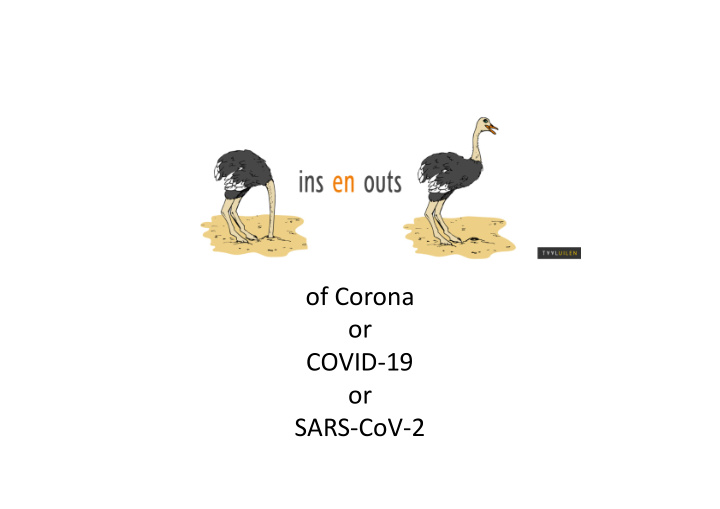



of Corona or COVID-19 or SARS-CoV-2
Achtergrond Corona • Viral infection • Symptoms: – Fever, headache, malaise – Cough, SILENT HYPOXEMIA, shortness of breath – Common cold, sneez – Reduced sense of smell or taste – Diarrea, abdominal complaints, anorexia 2
Infection • Via aerosol • Surface is only infectious for a short time • Unknown: faecal infection • Not aerogene!!! 3
PPE Source isolation OR isolation from environment • – Irrational and waste of PPE – Severe cough will lead to spread of the virus – NRM / nebulizers causes aerosols (N95 /FFP1-2) Infection through mucosa • – Nose / mouth / eyes – Mouth-nose mask, goggles OR faceshield Minimal infection through surface / aerosol • – Handhygiene and apron (to protect from cough) – Alcohol is enough – Virus dies quickly – Few viral particles on surfaces 4
• Pregnancy: – In case series no increased risk for complicated disease course – Most studies without pregnant/lactating women – No contra-indication lactation – COVID+: perform good handhygiene and use mask during lactation • Children – Mild disease course – Rare: hyperinflammatory syndrome / Kawasaki-like 5
Diagnostics PCR • – Nasopharynx – Feces CT-scan: typical abnormalities • Lab • – Lymfopenia – Inflammation: CRP, ferritine, D-dimeer – LDH Gastro-intestinal complaianst sometimes severe, diagnostics not useful • • Serology – Unknown what is the value of positieve immunology – No routine lab test 6
Clinical course Incubation: median 5-7 days • – Upto 14 days 0-7 days: viremia • – Complaints of a viral respiratory tract infection After 7-10 days often worsening occurs • – Pulmonary embolus – Immuno dysregulation – Viremia has gone down by now – Indication for the start of steroid therapy 80% asymptomatic – mild course • 7
Treatment There is no curative treatment available • – Chloroquine – Hydrochloroquine – Remdesivir – Steroids Supportive care • – OXYGEN – Nebulisation not standard required and harmful due to aerosol – Keep patients relatively dry – Anticoagulant therapy – Accept anorexia in early fase Bacterial superinfections are rare in 0-14 days • – In ICU watch out for central venous cathere infections and ventilatr associated pneumonia (VAP) 8
Remdesivir • Binds RNA transciptase with premature ending transciption (thus preventing replication) • In vitro and in vivo effect on MERS-CoV en SARS- CoV-2 reducing viremia en and lung tissue damage • Adaptive COVID-19 Treatment Trial (ACTT) – Multinational, randomized, placebo-controlled – Severely ill: reduced time to recovery – Effect most clear in NON intubated patients – No effect in intubated patients or in mild disease 9
Steroids (dexamethason) Unpublished data (RECOVERY studie) • – Randomised, open label, multicenter UK – Admitted patients – Dexamethason vs standard care – Lower mortality in dexa group • Severe patients (O2 suppletion) • Larger effect in IC patients • No effect in patients without O2 suppletion Unclear what er the exposure risks • – Disadvantages – Influence on the course of viremia – Time of start dexa – Trial studied both suspected and confirmed patients 10
RECOVERY trial • Different treatment strategies vs standard care – 6425 participants in preliminary analysis • 2104 dexa-group • 4321 control group, 7% cross over dexa – “a few” HCL, lopinavir/ritonavir, remdesivir. Tocilizumab 11
• Skewed age distribution ventilated patients mostly <70 yrs >80 yrs rarely 1% ventilated • Very few pregnant women and children • Treating physician allowed to issue a contra indication for steroids. In that case the patient was not randomised for steroids 12
Downside of steroids • Steroids may exacerbate late infections • Steroids may decrease clearance of the virus Steroid cause hyperglycemia and fluid retention 13
Hydrochloroquine • Increase endosomal pH, virus cannot fuse with host-cel • retrospective studies • Bias in treating only the most severely ill patients • RCT’s underpowered • Lancet publication with unreliable data (withdrawn) • No evidence for effectiveness, a lot of side effects. • NOT standard treatment 14
Complications • COVID worsening – Fever (peaks) – Desaturation, tachypnea, HYPOXEMIE – Increase in X ray abnormalities – Knowing the clinical course very important 15
Pulmonary Embolus (PE) • 17% ICU pt have PE despite profylaxis • No deep venous calf thrombosis, origin is in lung cirulation • Not clear how many complications happen using standard therapeutic anticoagulation • Diagnostics limited – Clinical picture: thoracic pain, sudden worsening (pulmonary or hemodynamically) – ECG – Difficult to differentiate from COVID progression / hyperinflammation – D-dimer 16
Complications • Hyperhydration / ARDS – Endothelial leakage – Exacerbated by increased volume therapy – AFib with congestive heart failure • Hypertension / diabetes: – Glucose curves – Dehydration/ keto-acidosis with clinical picture of increasde respiratory failure (Kussmaul) 17
Deterioration / Assessment at ward ABCDE – OXYGEN • – RR >20 – Desaturation <95% Be alert = control in 30 minutes • Be alert to prevent fast deterioration / exhaustion • Fever • – Take bloodcultures – Sputum cultures (non ICU) not usefull – Procalcitonine (PCT when in doubt – NO standardized antibiotic therapy – IF you start antibiotics: stop if cultures are > 72 hs negative, low PCT 18
ABCDE • A: spontaneous breathing, talks • B: saturation, resp frequency, work of breathing • C: bloodpressure, pulse, diuresis, fluid balance • D: glucose, consciousness, delirium • E: temp, gastro-intestinal • Medication, stimulate mobilisation 19
• Admission on the ward: – Always evaluate the patient by yourself – Have nurse check vital parameters – Transport may lead to clinical wordening – Walk through the flow chart! – Re-evaluate pt • 30 min after adaptation of O2 • 1 hour after insulin administration • Confer with internist lwhen in doubt!! 20
• Rounds: – Use ABCDE methodology – Make sure to have vitals ready before the start – Make sure nusre is present during the rounds with you Practice NOW to be prepared LATER 21
22
Recommend
More recommend